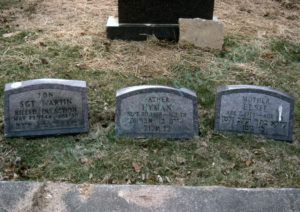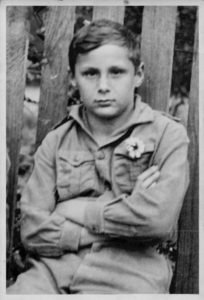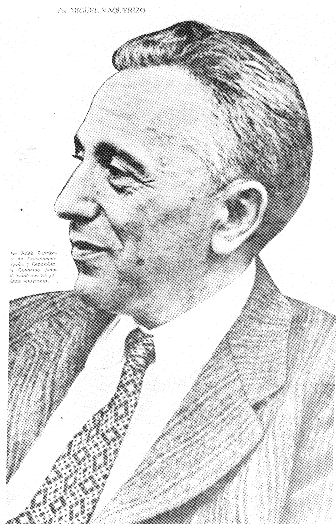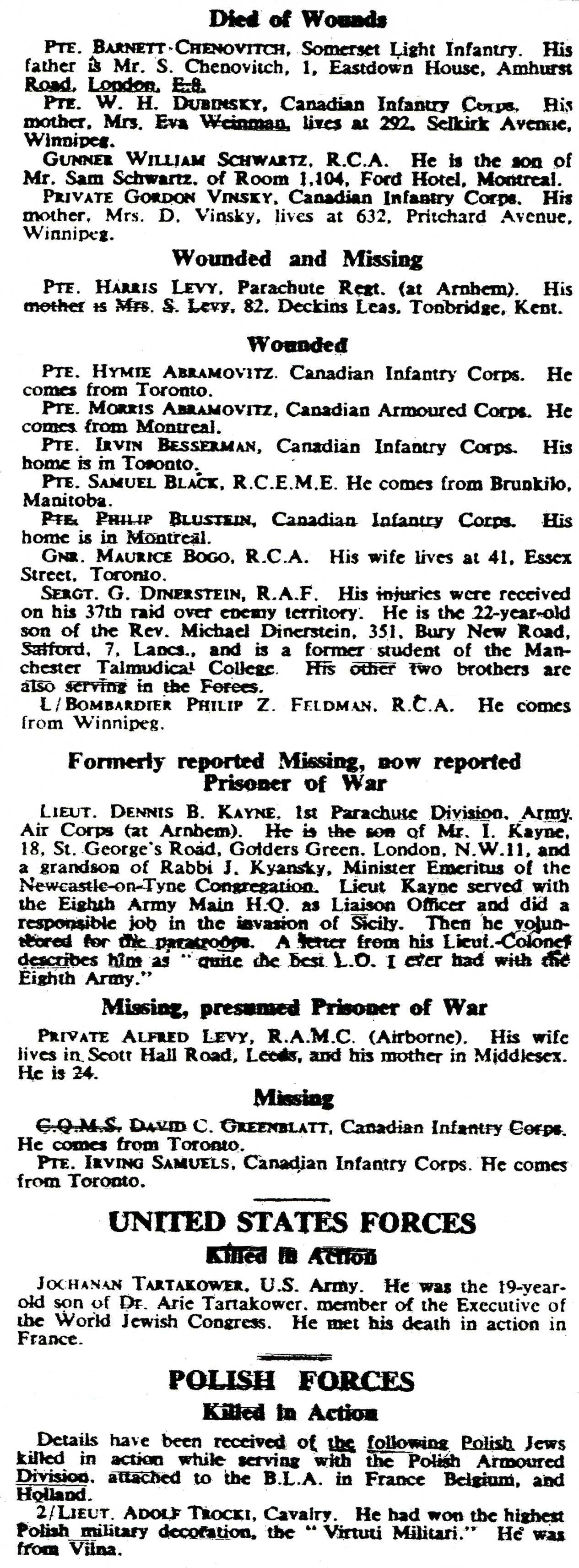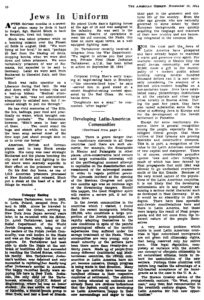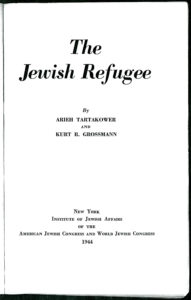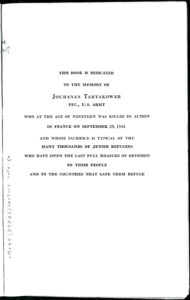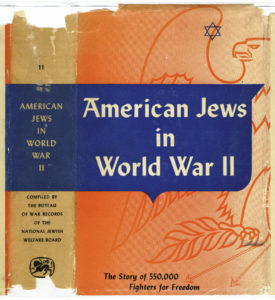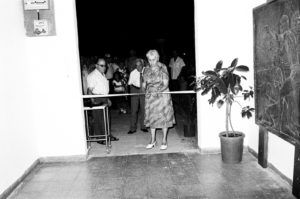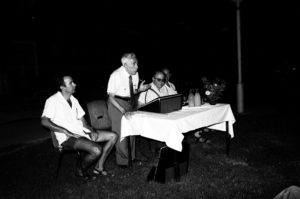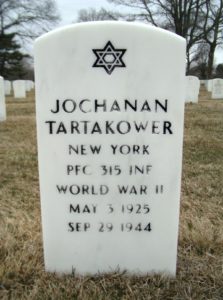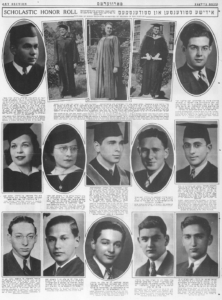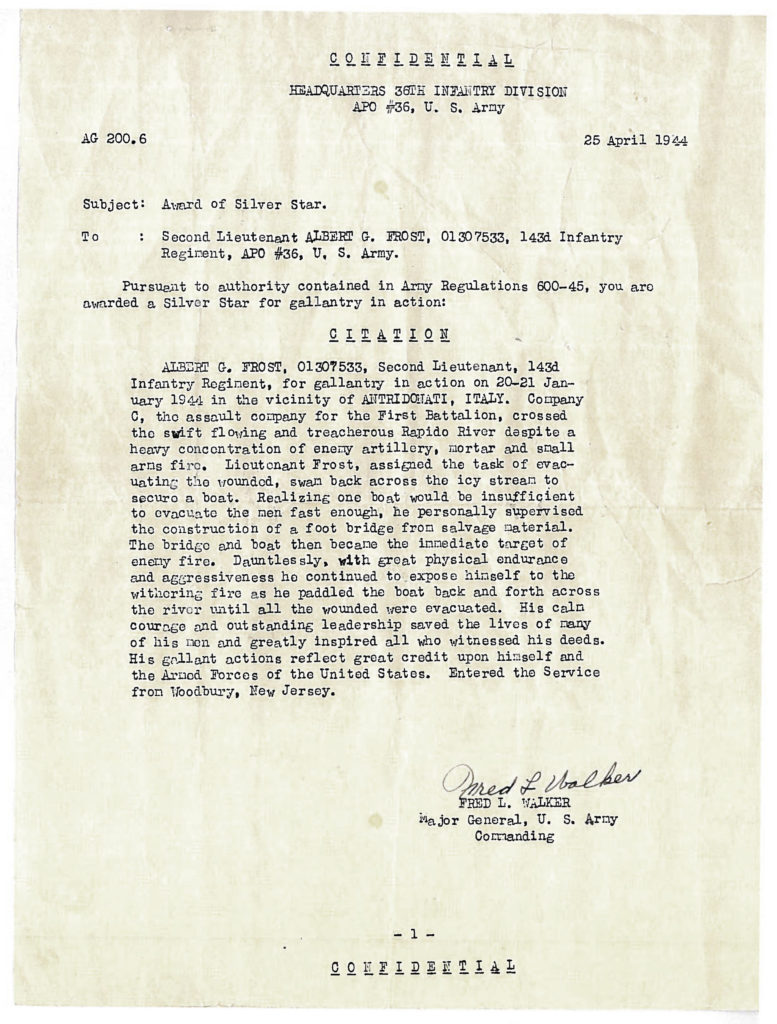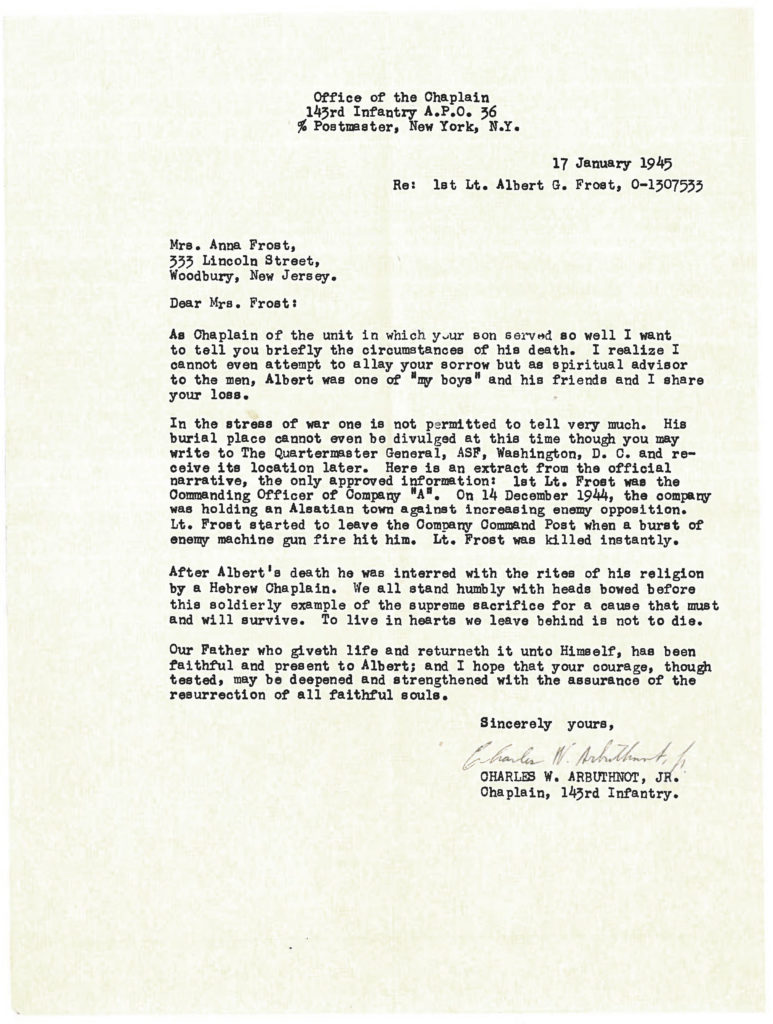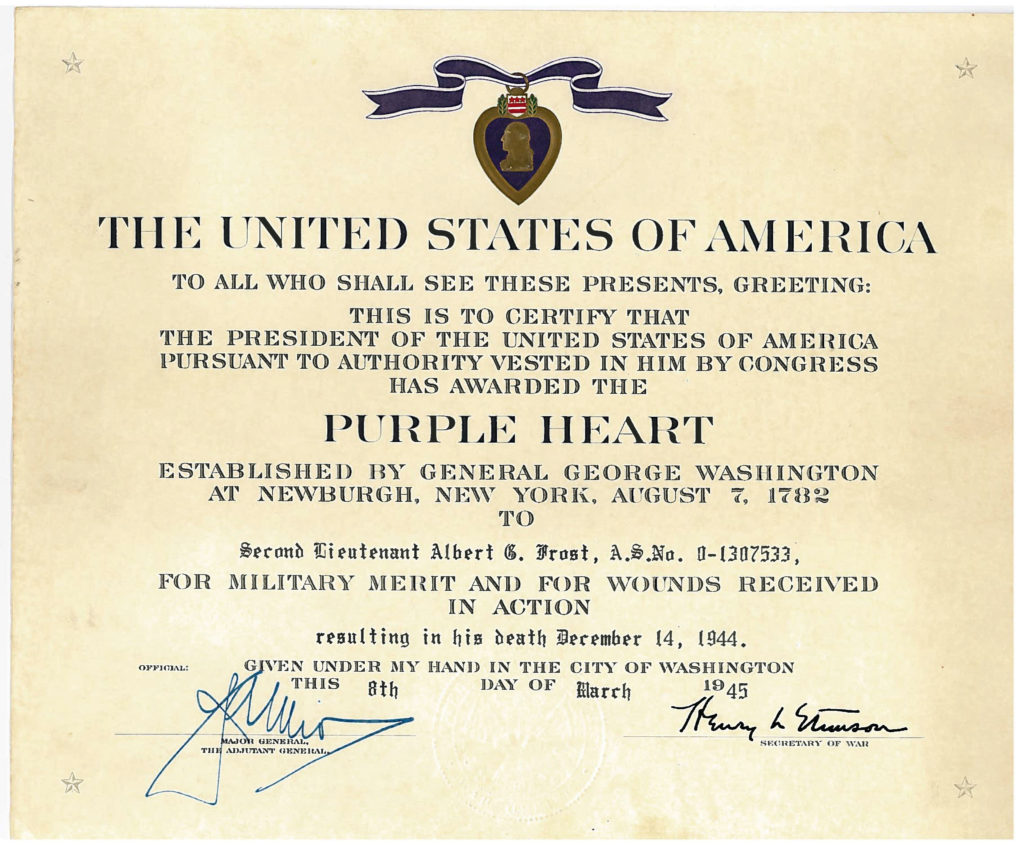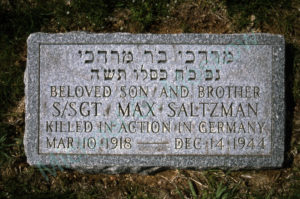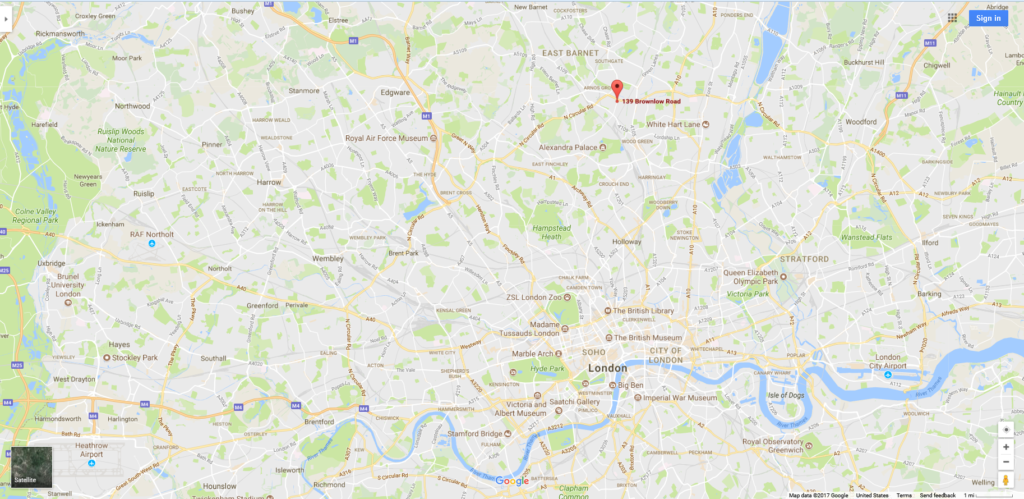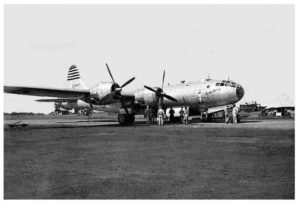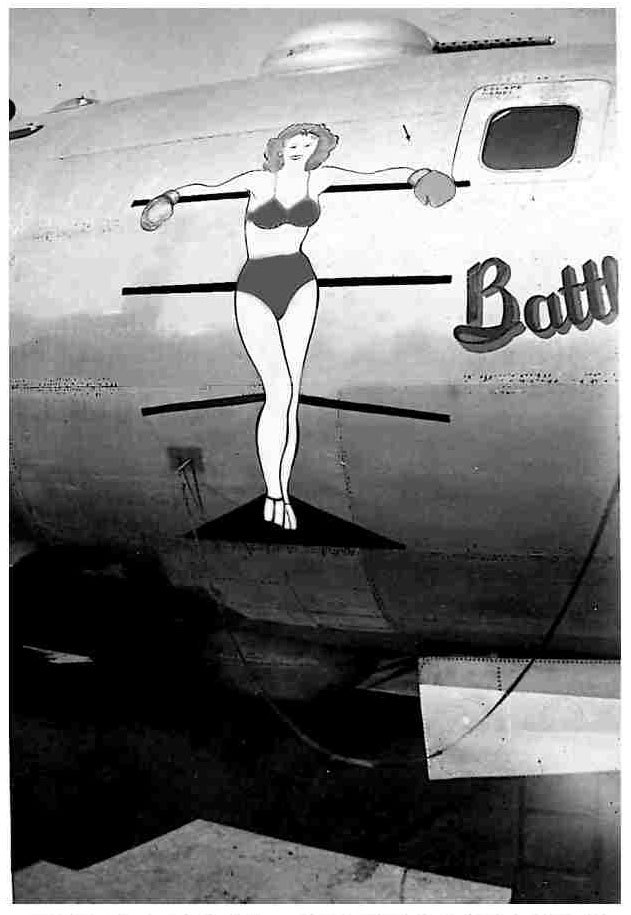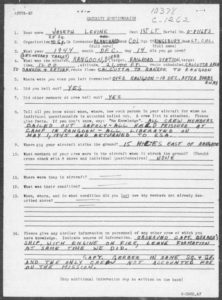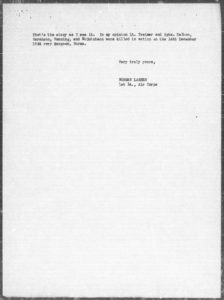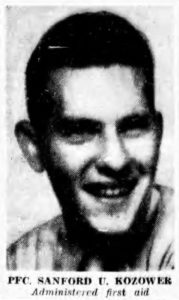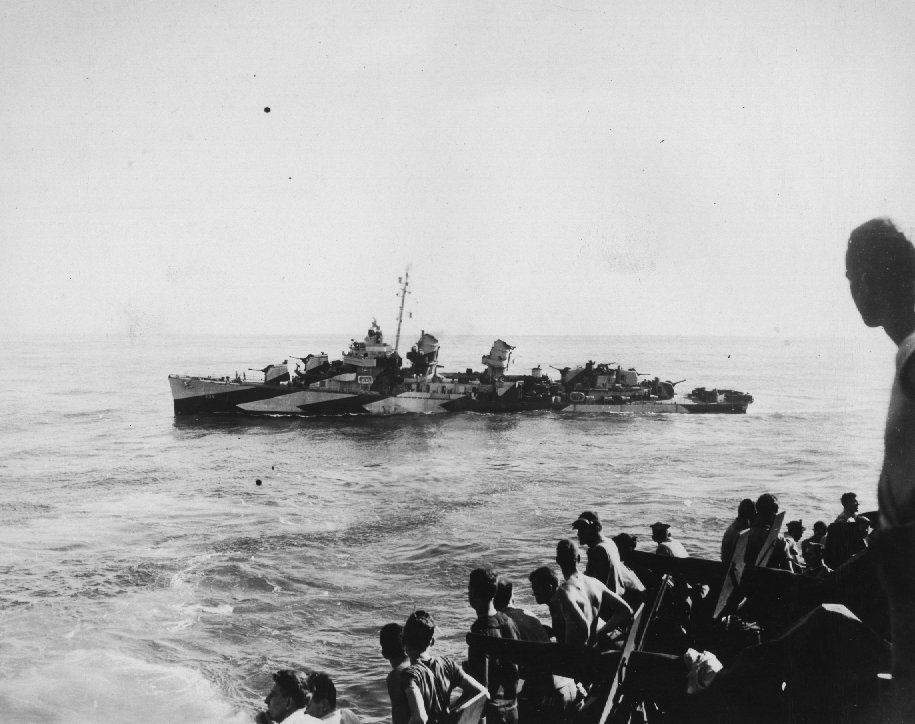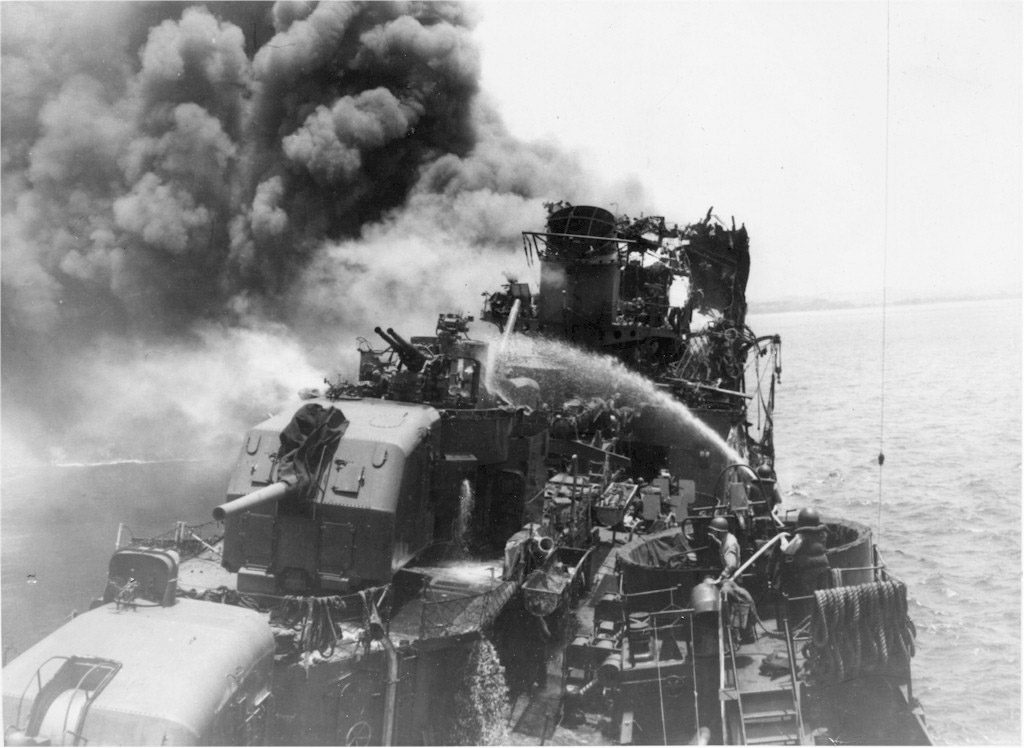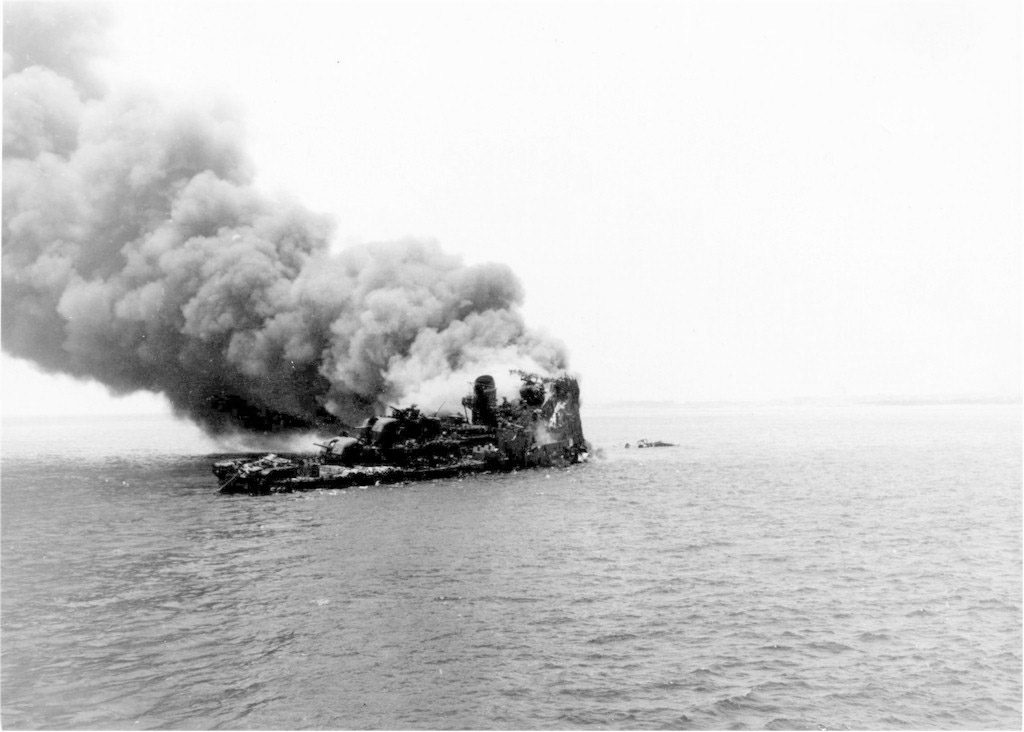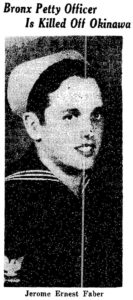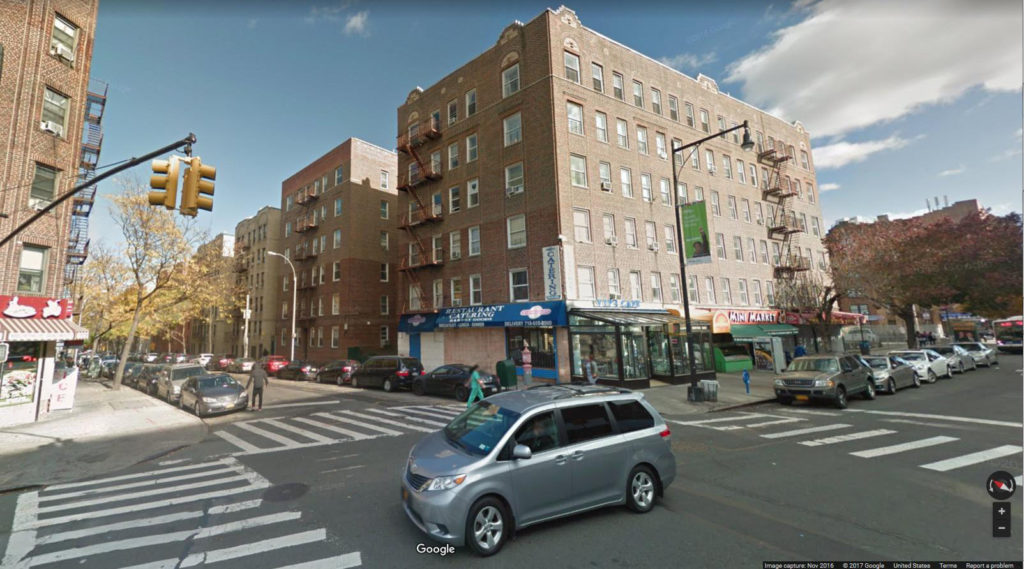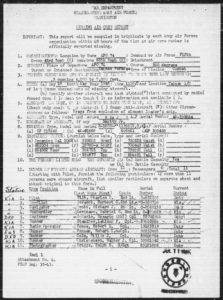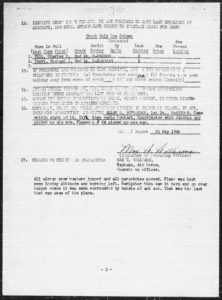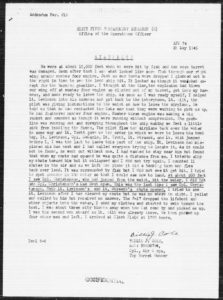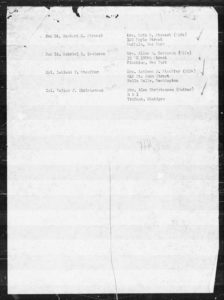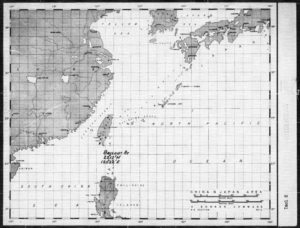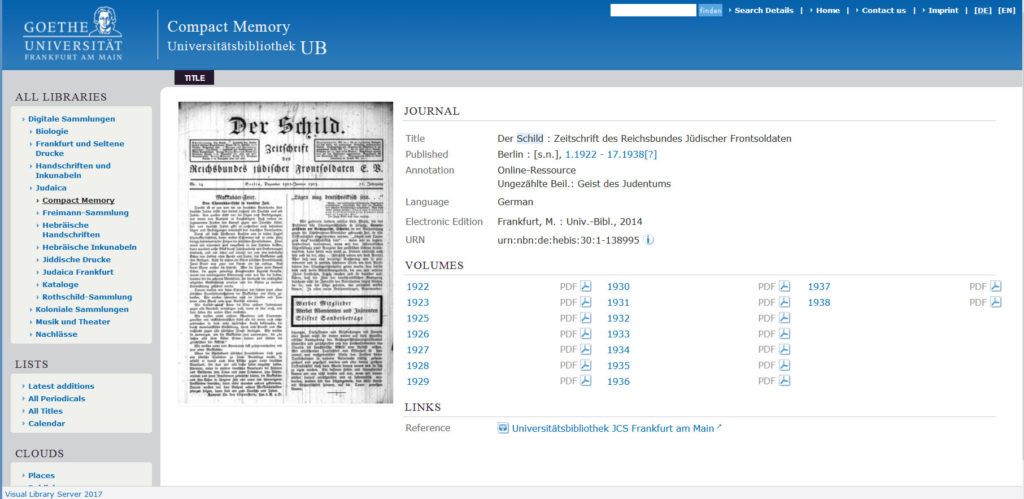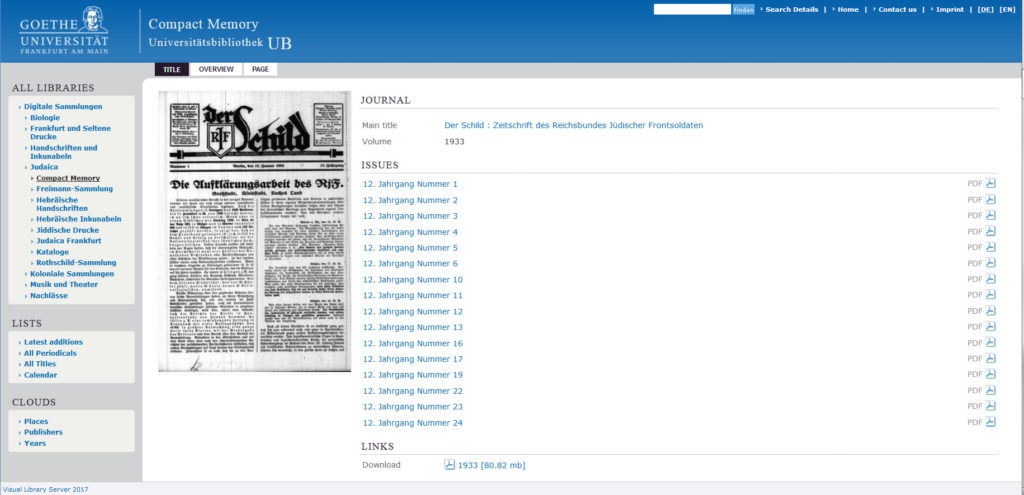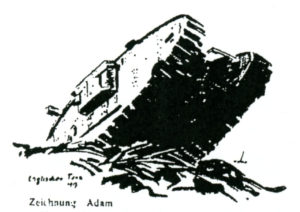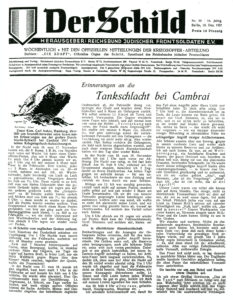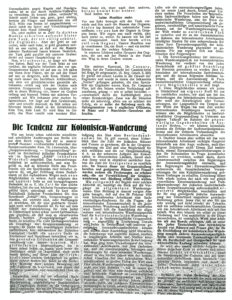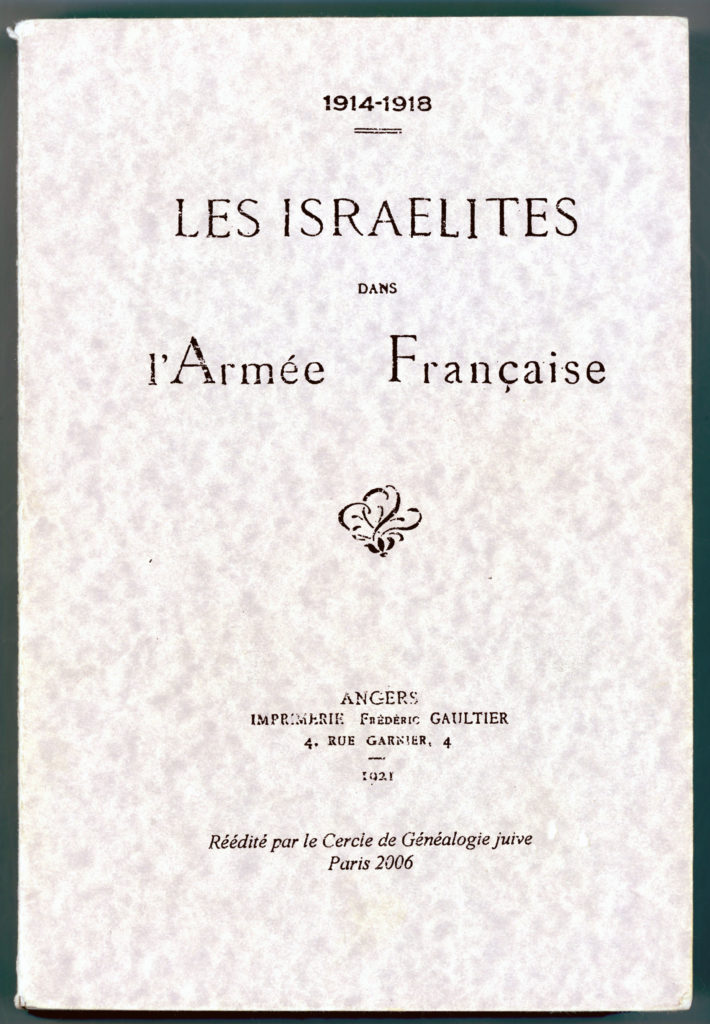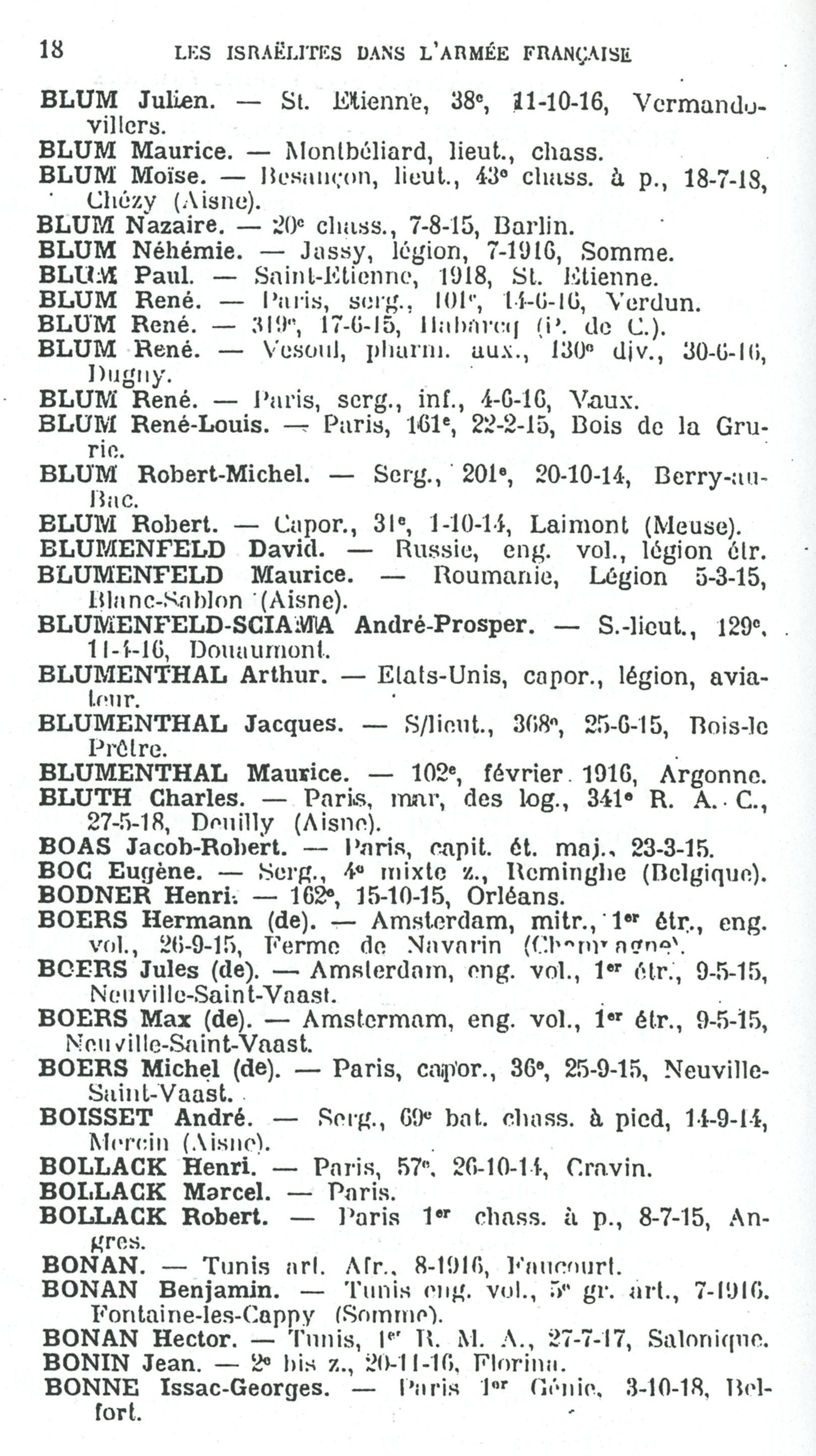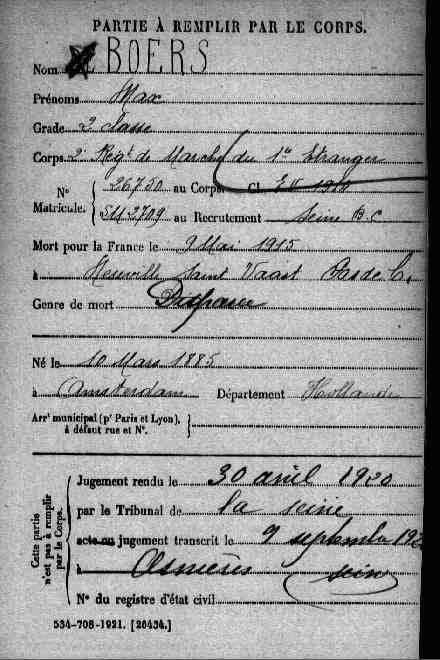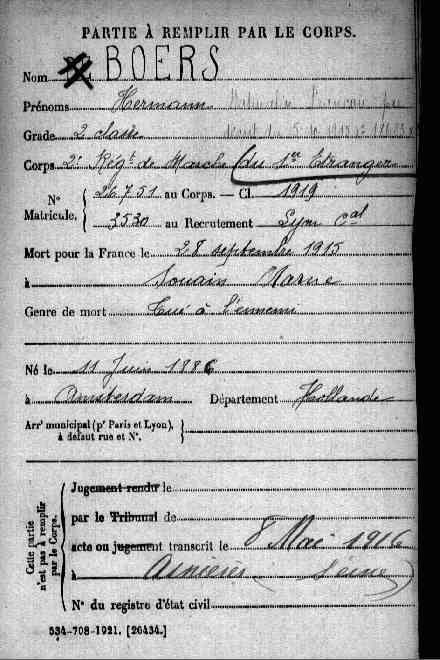A war ends.
But, it may never really “end”, especially for the families of servicemen who remain missing: those who lost their lives under unknown circumstances, or those whose ultimate fates were known, but whose bodies were neither identified nor recovered, and who thus have no definite place of burial.
The centrality of this aspect of military commemoration, and in turn, human memory – both collective and individual – is exemplified in the Funeral Oration of Pericles, which is dated to approximately 431-430 B.C.E. Recited in accordance with the annual custom of the Athenians, his speech was presented in memory of Athenian military dead of first years of the Peloponnesian War. Pericles particularly called attention to the Athenian practice whereby, “…an empty bier is decorated and carried in the procession: this is for the missing, whose bodies could not be recovered.”
Though the Second World War ended seventy-two years ago, there are still innumerable military dead from that conflict who have never been recovered and have no place of burial, or, whose final fate remains unknown. Among the 407,300 Americans military deaths from that conflict there are some 73,000 who remain unaccounted for. Through the efforts of the Defense POW/MIA Accounting Agency some will, in time, certainly be found. Others, due to either the circumstances or locations in which they were lost, will probably remain missing.*
One missing serviceman was Second Lieutenant Herbert Forman (serial number 0-807304) of the Bronx. Reported Missing in Action in a Casualty List published on June 30, 1944, his name appeared in a Casualty List of Killed in Action published on March 3, 1945.
His obituary – below – appeared in the Times two days later: on March 5, 1945.
Eighth Air Force Pilot Lost in Action Over Europe
Second Lieut. Herbert Forman, a fighting pilot with the Eighth Air Force in England, was killed in action over western Europe on May 23, the War Department has informed his parents, Mr. and Mrs. Samuel J. Forman of 3222 Cambridge Avenue, Riverdale, the Bronx. Recently also his family heard officially that his brother, Sgt. Martin S. Forman of the Infantry, their only other child, had been seriously wounded in Luxembourg.
Twenty-two years old, Lieutenant Forman was born in New York. He was graduated from De Witt Clinton High School in 1938. He attended New York University, where he was active as a photographer, and then went to Georgia University, where he played the saxophone and clarinet in the university band. Majoring in journalism and economics, Lieutenant Forman was a senior at Georgia when he joined the Army in 1942.
He was reported missing in a message received on D-day, June 6. On Jan. 11 his parents heard that he was dead.
The son of Mr. and Mrs. Samuel J. and Sadye L. Forman, Herbert served as a 9th Air Force P-38 Lightning fighter pilot in the 401st Fighter Squadron of the 370th Fighter Group. Shot down while piloting P-38J 42-68179, his name is commemorated upon the Tablets of the Missing at the Cambridge American Cemetery, in Cambridge, England. The recipient of the Purple Heart, he was also awarded the Air Medal and one Oak Leaf Cluster, suggesting that he’d completed approximately 10 to 15 combat missions by the time of his death. His name appears on page 311 of American Jews in World War II.
Herbert’s brother Martin, who was severely wounded in the Battle of the Bulge, passed away on April 6, 2011.
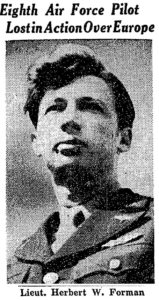 This image is a June, 2014 Oogle Street view of the possible location o the Forman family’s wartime home: 3222 Cambridge Avenue, in the Bronx. (Is this the “original” building where the family resided, or a newer residence constructed subsequent to the Second World War? The right “wing” of the apartment – or condo? – appears to be of substantially newer architecture than the left …)
This image is a June, 2014 Oogle Street view of the possible location o the Forman family’s wartime home: 3222 Cambridge Avenue, in the Bronx. (Is this the “original” building where the family resided, or a newer residence constructed subsequent to the Second World War? The right “wing” of the apartment – or condo? – appears to be of substantially newer architecture than the left …)
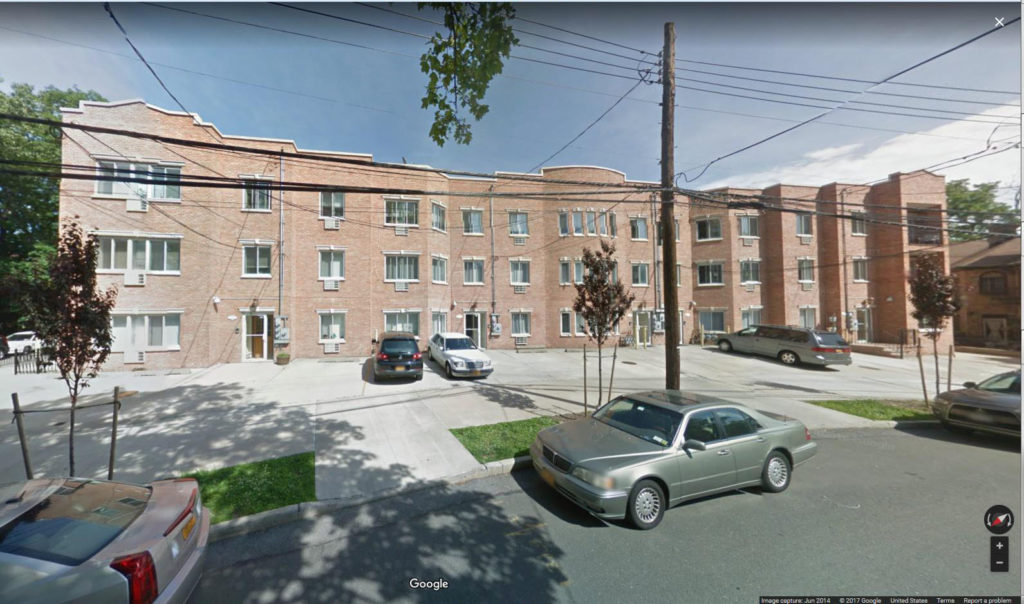 Unlike the other servicemen whose obituaries in The New York Times have been presented in this blog, several photographs and a published account exist concerning Lieutenant Forman.
Unlike the other servicemen whose obituaries in The New York Times have been presented in this blog, several photographs and a published account exist concerning Lieutenant Forman.
The image below was taken at Craig Field, Alabama, while Herbert Forman was an Aviation Cadet. He was commissioned as a Second Lieutenant and received his “wings” as graduate of class 43-G on July 28, 1943.
The portrait is from a collection of several thousand such images, in the United States National Archives collection of “Photographic Prints of Air Cadets and Officers, Air Crew, and Notables in the History of Aviation – NARA RG 18-PU”. (Specifically, within Box 30.) You can find more about this collection in the post Five Pilots in December at my brother blog, The Past Presented.
 The next two images can be found in Jay Jones’ 2003 book The 370th Fighter Group in World War II – In Action Over Europe with the P-38 and P-51. The first photo is a simple portrait (an officer’s identification card photo?) of Herbert Forman as a Lieutenant, while the second shows him posing before a P-38J Lightning undergoing repairs, probably at the 370th Fighter Group’s base at Andover, England. (The 370th Fighter Group credits both images to John and Ruth Fulton.)
The next two images can be found in Jay Jones’ 2003 book The 370th Fighter Group in World War II – In Action Over Europe with the P-38 and P-51. The first photo is a simple portrait (an officer’s identification card photo?) of Herbert Forman as a Lieutenant, while the second shows him posing before a P-38J Lightning undergoing repairs, probably at the 370th Fighter Group’s base at Andover, England. (The 370th Fighter Group credits both images to John and Ruth Fulton.)
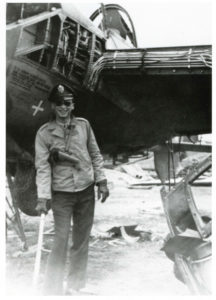 This excellent photo, from the American Air Museum wesbite, is from the Roger Freeman collection (as image FRE 10071), and shows Lieutenant Forman (most definitely!) at Andover, England. The camera is not surprising, as the Times’ obituary notes Lt. Forman’s interest in photography. Note the “natural-metal” (sans camouflage paint) P-38J at the right.
This excellent photo, from the American Air Museum wesbite, is from the Roger Freeman collection (as image FRE 10071), and shows Lieutenant Forman (most definitely!) at Andover, England. The camera is not surprising, as the Times’ obituary notes Lt. Forman’s interest in photography. Note the “natural-metal” (sans camouflage paint) P-38J at the right.
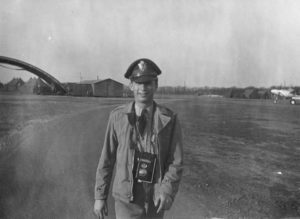 In The 370th Fighter Group in World War II, Jay Jones provides a very detailed account of the Group’s mission to Coblenz, Germany on May 23, 1944.
In The 370th Fighter Group in World War II, Jay Jones provides a very detailed account of the Group’s mission to Coblenz, Germany on May 23, 1944.
The 370th lost three pilots that day: Lt. Forman – covered in Missing Air Crew Report (MACR) 6505; 1 Lt. Herbert R. Schultz (also of the 401st Fighter Squadron) in P-38J 42-67278 – covered in MACR 6506; 1 Lt. Maurice B. Thibert (of the 402nd Fighter Squadron) in P-38J 42-104066, covered in MACR 6497. Of the three, only Lt. Schultz returned. Captured, he spent the remainder of the war as a POW at Stalag Luft III, Sagan, Germany. Jay Jones’ account concludes with Herbert Schultz’s “shoot-down”, in the latter’s own words.
The account proceeds…
From the Clouds to the Deck
The pilots flew a boring escort on the morning of May 23, and then a field order arrived the pilots had been waiting for. The 370th would finally let loose all of its destructive tactical power against targets on enemy soil. Forty-eight Lightnings were sent in to bomb the marshaling yard at Coblenz. After the bombing, the pilots hit the deck and flew back toward the English Channel strafing whatever they could find. Each plane carried one belly tank and one 1,000 pound bomb.
Capt. Charles D. “Wick” Wickliffe of the 402nd Squadron recalled,
It was in the late afternoon, late enough that it was going to be a little iffy when we were getting back. We had forty-eight P-38s up. Before we got to Coblenz, we had gotten rid of our belly tank. We dropped our bomb and we dropped down, and that was called a rhubarb. We went on the deck. It got scattered. Everybody was scattered all over the landscape. It was incredible. I don’t think there were any two airplanes that were even close together. I had my bearings and knew where I was going, and it was in the direction of Holland. I was down on the deck and it was kind of pleasant, cruising at about 200 or a little better. I’d see a flak tower coming up and I’d cruise over and give it a squirt. There would be a lot of action and everybody that was there ducked and I would go over the top and put a little rudder on it and the gunner would shoot ahead of me.
He referred to a flak evasion trick of using the rudders to put the plane in a skid to the left or right, throwing off the gunner’s aim.
Wick continued,
I’d burned up a lot of fuel, but I still had an adequate amount. I saw a troop train and it was down sort of in a hollow. There were some trees that I could see that were protruding up. I started to make a big swing to get up to start strafing it. At the same time I had an eye on where I was going to start my strafing run. I remembered to keep a lookout for the trees along there. I started my strafing run and began to fire and quickly pulled up and started another run. As I dropped down I flew right through a tree. It wasn’t a bush-it was a tree. That P-38 cut right through that tree. The airplane staggered, and my thought was this was what you would call a fireball in an instant. That airplane staggered up and I wondered what was keeping it up. It was moving and pulling up, although it was pretty slow. The windshield was totally green. You couldn’t even see out of it. I couldn’t believe that airplane was still flying. When I went through the tree it took off all of my antennas. There was no conversation with anybody, anyplace.
I got oriented and I knew I was going in the direction of England. As I climbed up I could see out one side and the other to see what was going on. I got up to about 10,000 and I realized that I flew right over a German airdrome. They had the Focke-Wulfs lined up all over the place. I was up at 10,000 feet looking down, and that’s not too far down. They didn’t come up.
I got over the Channel and I was surprised, pleasantly so. It was getting darker. I began to lose my bearings. I wasn’t quite sure where I was, except that my general heading was okay. I had dropped down to about 2,000 feet in order to get myself out of the airplane if I could. The bail-out techniques for getting out of the P-38 were wishy-washy. Nobody had a good idea of what the best way to do it was. I was getting low on fuel. I had to make a decision of whether to bail out or go in. At that time I could see ahead a fighter airdrome. I slowed the airplane down to about 170, and the airplane started to fall out. I realized that all of the lift inboard was all smashed out. The only thing I was working on was the outboard wings. The rest of it was just like it was hit by a hammer. I was looking at landing at about 175 miles per hour. I went in and made a good landing. The fuel gauges were on zero and it was quite dark when I finished my roll out. I didn’t have any brakes, either. I hit the brakes, what they were, and it spun the airplane around. They just took the P-38 and trashed it. I got a new one.
It was very stressful when all these things were happening to me. You can do everything when you have a real load of stress on you. but when I got out of that airplane I put a cigarette in backasswards. I had a couple of big drinks real quick. It was an exciting trip.
The mission not only was iffy because of the late start, but also because of the weather. There was a solid overcast from around two to four thousand feet up to ten thousand feet. There was also problems with the aircraft icing up. Seth McKee, leading the mission, recalled,
All of our missions were scheduled by the Ninth TAC, commanded by Pete Quesada. He decided he wanted to see what we could with targets of opportunity strafing at low level. The weather was pretty bad. We hit the deck, forty-eight aircraft line abreast, about a hundred yards apart, and headed back toward England strafing targets of opportunity. We hit all kinds of targets.
The thing I remember most about it was the weather started getting worse and worse as we were going further toward home. Finally, I ended up over some city, I still don’t know which it was, probably Brussels, Belgium. 1 remember seeing church steeples going by me at higher altitudes that I was. The weather was so bad I called the mission off. I said, “Hey guys, we’ll break it off now. We’ll climb out, join up and go home.” I climbed up, broke out. I looked around and I had forty-eight aircraft with me, but I only saw two other aircraft in the sky. I thought, “I’ve lost the whole damn group!” One was a squadron commander and the other was the Group Operations Officer, Major Lee Hoddy. They formed up on me and we went back.
The weather was horrible in England. In those days we had no radar-controlled approaches and that sort of thing. You had a beacon and you let down off of a heading. With a proper rate of descent if you broke out at all you saw the airfield. If you didn’t you would try it again. Anyway, we recovered with no problem. I was really, really worried about the group. I found we lost three aircraft out of forty-eight. They recovered all over England because the weather was so bad. They just got in wherever they could. But, I’ll never forget I thought, “My God, I’d lost the whole damn group.”
Lt. Bud Gewinner was almost a casualty on this mission. He wrote in his diary,
I hit the deck at about 300 M.P.H. and started looking. What I wanted to find was a train. I found this one train steaming around a bend and came down on the engine, throwing all the lead I could. Before I pulled up I saw the boiler explode. As I pulled off the target I saw tracers going by me. The next thing I found was a flak tower. I came in level and really peppered it. They threw so much back at me, I don’t know how they missed.
A short while later I felt an explosion on my ship and the cockpit got smoky. Believe me, I started sweating. I must have passed near some guns I hadn’t seen. I twisted and turned all I could right down to the deck to get out of their fire. I found another train after that and got its engine too. I was getting low on ammo and gas so I headed home. I had plenty of doubts while crossing the Channel because I didn’t know how badly old “Spooks” was damaged. When I got back I found that a 20mm cannon shell had exploded in the nose section. Those strafing jobs are mighty rough. I have never spent such an excitement-packed half hour in my life. It’s a weird feeling to see dozens of tracers whizzing by your ship.
Lt. Gene Baker of the 401st wrote in his diary that night,
We weren’t on the deck for more than 15 minutes when Watson picked up some tel. wires so I went back up through overcast with him. He was on his right engine so no radio conversation. As we got to the coast the flak guns got us pinpointed and gave us a burst. Watson got some in dead engine. I got some in tail, left wing tip tank, right wing main tank, right prop hub & glances off nacelle. We landed at aux field & then I came on home.
The mission really wasn’t as successful as one might think. A group of P-38s spread out on the deck tearing across the countryside sounds dangerous, but it was an ineffective use of men and firepower. Al Bouffard recalled,
Lt. Thibert was the first one we lost on a mission. He was my wingman on that mission. They said hit the deck and whatever you see, shoot it up. When I came down on the deck and we split apart – Thibert was over there somewhere – I was going along and the only thing I saw was farms and farmers. I didn’t see a damn thing except farms and farmers out in the fields working. I’d go by and waggle my wings and keep going.
I saw this tower. They used to raise these towers and put flak guns up there. I said, “Boy, there’s a flak tower. I’ll get that son of a gun.” I aimed for it and started shooting at it. Nothing was coming at me. When I got closer – it was a water tower.
Finally got back and Thibert never made it back. I have no idea what happened to him.
Lt. Maurice B. Thibert of the 402nd, from Detroit, Michigan, was confirmed as killed in action.
Second Lt. Herbert Forman of the 401st also failed to return from the mission. Lt. Joseph Ogrin was the last pilot to see Forman. He noticed Forman on the left flank of the low-level attack heading roughly southwest. Herb was listed as missing in action but was most likely killed.
First Lt. Herbert R. “Dutch” Schultz of the 401st was almost to the French coast when a flak battery opened up or him. Schultz had joined up with Lt. Walter “Little Red’ Stephens of the 402nd to come out over the Channel. Little Red reported,
I saw Lt. Schultz’s plane explode and felt the blast of the explosion. I went into a climb pulling 65 to 70 inches in an attempt to dodge flak. I looked back and saw a parachute quite a way below me, since I was climbing very rapidly.
Herbert Schultz recalled,
We had never had any training at skip or low level bombing so my bomb skipped completely over an inverted banked up “Y” in the rail junction I had planned to obliterate, and exploded harmlessly in a nearby stand of small pines. But shortly thereafter I got lucky when a locomotive was traveling 90 degrees to my course and directly in front of me. My first long burst disabled him spewing steam in all directions and as I went by I saw two 38s from our group had turned around and were going back to finish him off, so I continued on.
I also had an encounter with a flak tower before I hit the coast. As soon as I spotted it I pulled the nose up to give my guns more range and opened fire hoping to encourage them to keep their heads down. I could see people moving around on the top platform but I got no return fire. As I went by I could see it was something like a silo only an open platform under the roof at the top. Perhaps they had guns in it at one time but fortunately not when I went by.
By this time my fuel was getting low because we were traveling about 260 mph, normal for strafing. So, I pulled up and picked up my safe course home not having the slightest idea where I was.
It turned out I was just out of Calais, France, and took a direct hit from one of the many 88s in the area. When captured after parachuting the krauts explained it emphatically, “For you, the war is over.”
Lt. Schultz was sent to the Luftwaffe interrogation center at Oberursel, near Frankfurt, Germany. There, downed fliers were questioned by crafty interrogators attempting to trick them into giving away information. Throughout the remainder of the war many downed 370th pilots went through Oberursel for interrogation on their way to the infamous Stalags.
______________________________
While there was an eyewitness to Lt. Schultz’s loss (2 Lt. Walter C. Stephens, whose account in Missing Air Crew Report (MACR) 6506 is quoted above), there seem to have been no American witnesses to the loss of either Lt. Forman or Lt. Thibert. Well…at least, the MACRs for both pilots contain no specific accounts describing their loss. Instead, both MACRs simply include 1:4,000,000 scale maps of Continental Europe with the notation “MIA Return Trip Coblenz to Andover last seen slightly west of Cloblenz”.
The MACR for Lt. Forman is presented below:

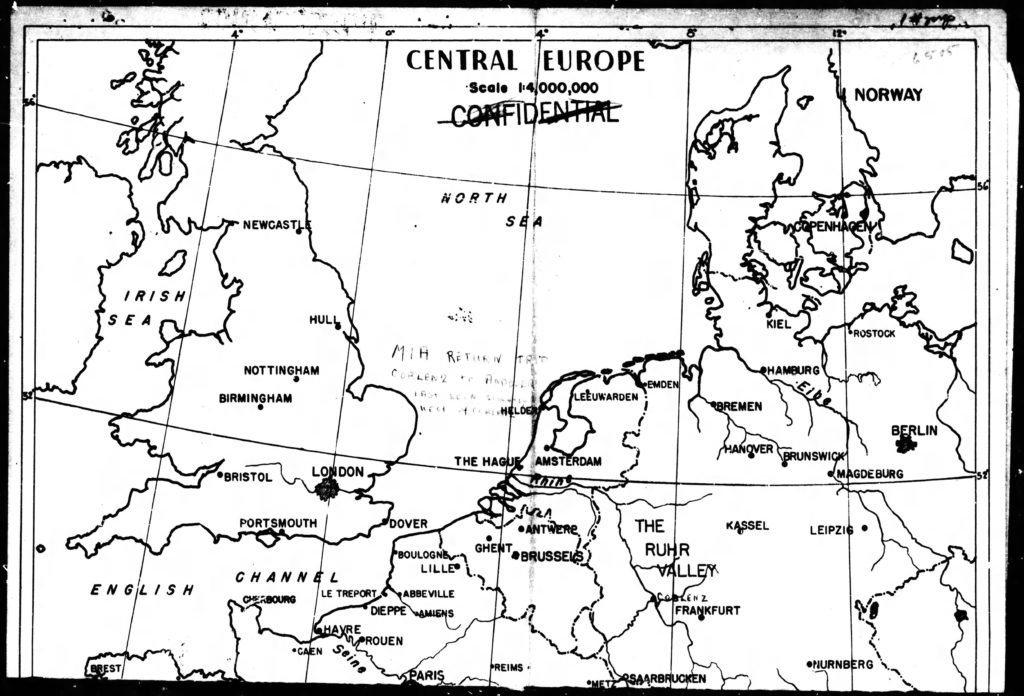 This is the MACR for Lt. Schultz:
This is the MACR for Lt. Schultz:

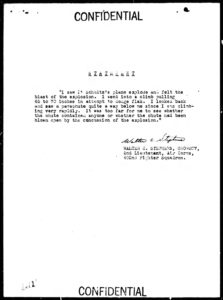 Though American documentation – in the form of MACRs – for the three pilots is scant to minimal, this was not so from the vantage point of German investigators. The losses of Schultz and Thibert were covered in Luftgaukommando Reports J 1181 and J 1179, respectively.
Though American documentation – in the form of MACRs – for the three pilots is scant to minimal, this was not so from the vantage point of German investigators. The losses of Schultz and Thibert were covered in Luftgaukommando Reports J 1181 and J 1179, respectively.
(But, what are Luftgaukommando Reports?… These are documents held within the United States National Archives “Collection of Foreign Records Seized” concerning Allied aircraft lost in the European and Mediterranean Theaters of War. In a general sense, these documents include information about the nature and circumstances (flak or fighters) as to how an American aircraft was downed and recovered in German-occupied territory, the location and condition of its wreckage, technical aspects of the plane or its equipment particularly noted by German investigators, and, nominal biographical information about aircrew casualties.)
Here is the English-language translation of Luftgaukommando Report J 1181 (for Lt. Schultz), which is included within MACR 6506… NARA’s master list of Luftgaukommando Reports correlates J 1181 to a point 2.5 kilometers southeast of Coulogne (a commune in Pas-de-Calais, immediately south of the city of Calais), France, at 18:45 hours.
 …and, here is the English-language translation of Luftgaukommando Report J 1179 (for Lt. Thibert), which is included within MACR 6497. NARA’s master list of Luftgaukommando Reports correlates J 1179 to “Steenocqerzeel” (Steenokkerzeel), Flemish Brabant, in central Belgium, at 18:15 hours.
…and, here is the English-language translation of Luftgaukommando Report J 1179 (for Lt. Thibert), which is included within MACR 6497. NARA’s master list of Luftgaukommando Reports correlates J 1179 to “Steenocqerzeel” (Steenokkerzeel), Flemish Brabant, in central Belgium, at 18:15 hours.
Notably, German investigators transcribed the next-of-kin information – the name and address of his mother – that had been embosed upon Lt. Thibert’s dog-tag…
No Luftgaukommando Report lists his name or is included within MACR 6505. However, a review of Luftgaukommando Reports filed for May 23, 1944 reveals a Report that I believe can circumstantially be correlated to his loss. This is Luftgaukommando Report J 1180.
This document consists of a single sheet with typewritten notation “23.5.44 – 18.35 – Coxyde i. See – Lightning – Fl. Pl. Kdo. [FlugplatzKommando] Coxyde – 1 unbekannter Toter”.
Here it is:
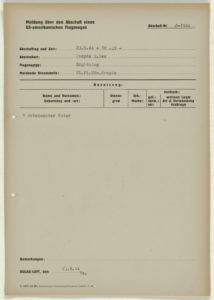 Translation? “May 23, 1944, at 18:35 hours (6:35 P.M.) – Coxyde, in the sea – Lightning – Airfield Command Coxyde – 1 unknown dead.”
Translation? “May 23, 1944, at 18:35 hours (6:35 P.M.) – Coxyde, in the sea – Lightning – Airfield Command Coxyde – 1 unknown dead.”
Apparently, Herbert Forman was shot down – probably – by anti-aircraft fire (Jan Safarik’s compilation of Luftwaffe aerial victory credits against P-38s shows no Luftwaffe aerial victories over P-38s for May 23, 1944) on the return flight to Andover, and crashed into the English Channel just off shore from Coxyde (“Koksijde”), Belgium. Maps of this area are presented below.
Northwest Europe, the English Channel, and southeastern England. Oogle Maps’ emblematic red location pointer is superimposed on Coxyde, Belgium.
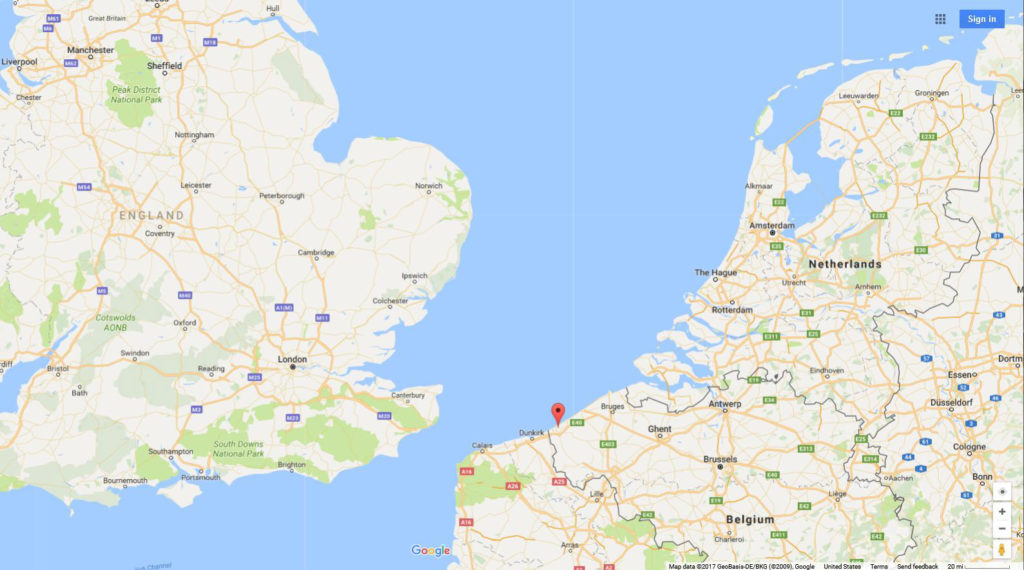 The Strait of Dover (with Dunkirk) and the Belgian coast. Coxyde (name not shown) is the area shaded in pink, just to the east of the Franco-Belgian border.
The Strait of Dover (with Dunkirk) and the Belgian coast. Coxyde (name not shown) is the area shaded in pink, just to the east of the Franco-Belgian border.
 The coastal town of Coxyde, the name of which appears as “Koksijde”.
The coastal town of Coxyde, the name of which appears as “Koksijde”.
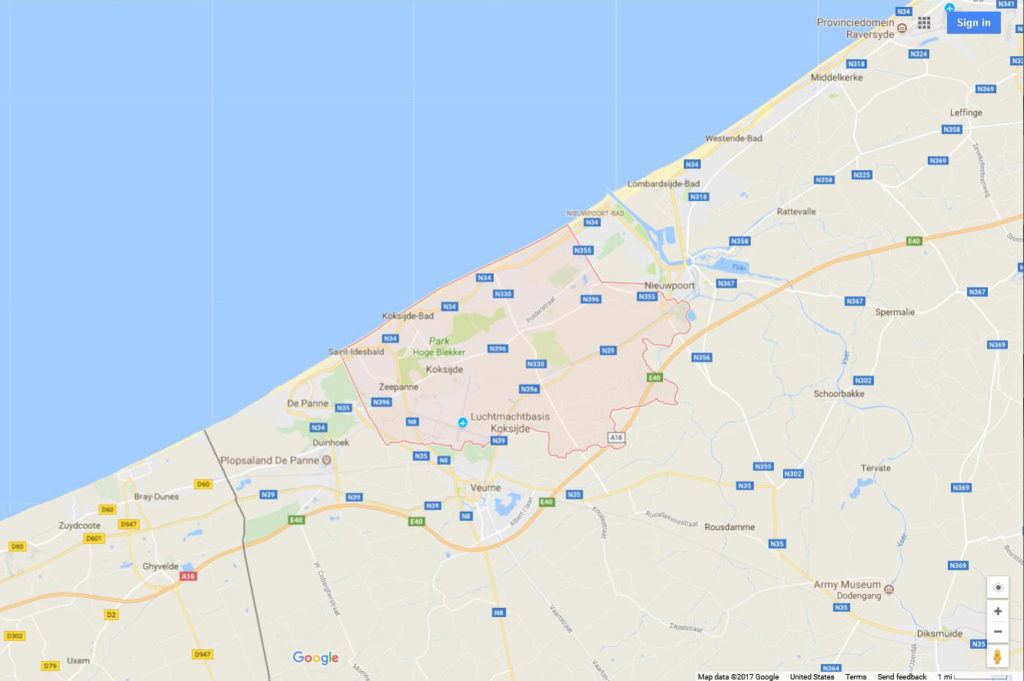 But, with all this, there remains an enigma. Herbert Forman’s obituary mentions that his parents learned on January 11, 1945 – four months before the war’s end – that he had been killed in action. Given that Luftgaukommando Reports were only accessed, investigated, and correlated to MACRs after the war’s end, what was the source of this information?
But, with all this, there remains an enigma. Herbert Forman’s obituary mentions that his parents learned on January 11, 1945 – four months before the war’s end – that he had been killed in action. Given that Luftgaukommando Reports were only accessed, investigated, and correlated to MACRs after the war’s end, what was the source of this information?
Was Herbert Forman recovered, and interred as an “unknown”?
That answer is unknown.
The image below – from Jay Jones’ The 370th Fighter Group in World War II – is an excellent representative view of a 401st Fighter Squadron P-38 Lightning, though almost certainly not the specific aircraft flown by Herbert Forman or Herbert Schultz on the mission of May 23.
The photograph clearly illustrates the 401st’s “9D” squadron identification letters painted on the aircraft’s tail booms, and, the individual aircraft-within-squadron identification letter (in this case, “E”) painted on both the “exterior” glycol radiator housing, and, interior surface of the plane’s twin fins and rudders. The black square on the exterior of the fin and rudder also designated the 401st Fighter Squadron.
Given that manufacture of “natural metal” (that is, un-camouflage-painted) P-38s probably commenced with aircraft 42-68008, Herbert Forman’s P-38J – 42-68179 – presumably had the same general appearance as the “silver” Lightning in this photograph.
______________________________
Some other Jewish military casualties on Tuesday, May 23, 1944, included…
Killed in Action
– .ת.נ.צ.ב.ה. –
Glanzrock, Murray G., S/Sgt., 14083453, Aerial Gunner (Left Waist), Air Medal, 2 Oak Leaf Clusters, Purple Heart
Mrs. Bea Glanzrock (wife), 1237 54th St. / 5001 10th Ave., Brooklyn, N.Y.
Born 1922
Epinal American Cemetery, Epinal, France – Plot A, Row 35, Grave 55
Casualty Lists 6/30/44, 3/1/45
American Jews in World War II – Not listed
(National Jewish Welfare Board index cards are stamped “No Publicity”)
Markus, Joseph R., Sgt., 36636142, Aerial Gunner (Nose Turret), Purple Heart
Mrs. Dorothy S. Markus (mother), 10512 Edbrooke Ave., Chicago, Il.
Epinal American Cemetery, Epinal, France – Plot A, Row 25, Grave 62
American Jews in World War II – 109
S/Sgt. Murray Glanzrock and Sgt. Joseph Markus were crewmen in B-24H Liberator 42-7583 “Wee Willie”; “FL * L”, of the 704th Bomb Squadron, 446th Bomb Group, 8th Air Force. Piloted by 1 Lt. James C. Blackwood, none of the plane’s crew of 10 survived. The aircraft’s loss is covered in MACR 5251 and Luftgaukommando Report KU 1930.
______________________________
Ruslander, Harold, S/Sgt., 20236617, Flight Engineer
Mr. and Mrs. Fred E. and Thressa F. Ruslander (parents), 5301 Fair Oaks St., Pittsburgh, Pa.
1 Lt. Solomon L. Ruslander (cousin?), Leesville, La.
Born Brooklyn, N.Y., 12/16/16
Entered active service in September, 1940, at Fort Dix, New Jersey
Honolulu Memorial, Honolulu, Hawaii – Plot Q-48; Buried 6/15/49
The Aluminum Trail – 142
The Jewish Criterion (Pittsburgh) 2/1943
American Jews in World War II – not listed
Sternbaum, Jacob Aaron, 1 Lt., 0-672704, Co-Pilot
Mr. and Mrs. Carl [11/17/88 – 3/3/54] and Mary E. (Yuwiler) [2/14/88 – 5/15/70] Sternbaum (parents), David, Max, and Minnie (brothers and sister), 169 Vale Ave., Mansfield, Oh.
Born 1923
New Albany National Cemetery, New Albany, In. – Section B, Grave 409A; Buried 10/27/49
The Aluminum Trail – 142
American Jews in World War II – not listed
1 Lt. Jacob A. Sternbaum and S/Sgt. Harold Ruslander were crewmen in a C-46 aircraft (41-107282) operated by Station 11 of the India-China Wing of the Army Air Force’s Air Transport Command. The aircraft’s loss is covered in MACR 5198. The plane crashed on a flight between Chabua and Misamari (both in India), the wreckage eventually being located in India’s Dafflaghur Hills (27 – 06 N, 93-24 E). Piloted by Captain Terry V. Prosper, none of the transport’s 4 crewmen survived.
______________________________
Bauman, Hans, Pvt., M/107479
Royal Canadian Infantry Corps, Loyal Edmonton Regiment
Cassino War Cemetery, Cassino, Frosinone, Italy – IX,F,10
Ben Avraham, Avraham Pall, Pioneer, 12648
Pioneer Corps
Dely Ibrahim War Cemetery, Algeria – 4,B,19
We Will Remember Them (Volume I) – 238
(We Will Remember Them gives name as “Ben-Avraham, Avraham”; Commonwealth War Graves Commission gives name as “Ben Abraham, Abraham Pall”)
Black, Bernard, Gunner, 558769V
South African Artillery, 6th Field Reserve Company
Mr. and Mrs. Samuel and Bella Black (parents), Johannesburg, South Africa
Born 1921
Bari War Cemetery, Bari, Italy – XIV,A,35
South African Jews in World War Two – page “x”
Einhorn, Philip, T/Sgt., 35008563, Bronze Star Medal, Purple Heart
United States Army, 37th Infantry Division, 148th Infantry Regiment
Mr. Joseph Einhorn (brother), Isadore and Eugene (brothers), 3436 Superior Park Drive, Cleveland Heights, Oh.
Born 1912
Manila American Cemetery, Manila, Philippines – Plot D, Row 6, Grave 93
Greater Cleveland Veterans Memorial – Record for Philip Einhorn Cleveland Press & Plain Dealer, June 6 and 9, 1944
American Jews in World War II – 485
Fisch, Arthur E., T/5, 39550181, Field Artillery, Purple Heart (Died of Wounds)
United States Army, 1st Armored Division, 91st Armored Field Artillery Battalion
Mrs. Goldie P. Fisch (mother), 2148 ½ City View, Los Angeles, Ca.
Born 1922
Place of burial unknown
War Department Release 8/24/44
American Jews in World War II – 42
Fried, Carl Melvin, Pvt., D/82925
Royal Canadian Infantry Corps, Seaforth Highlanders of Canada
Mr. and Mrs. Max and Rose Fried (parents), 7 Park St., Sydney, Nova Scotia, Canada
(also) 15 Yates Ave., Newark, New Jersey, United States
Born Glace Bay Nova Scotia, Canada; 4/23/13
Cassino War Cemetery, Cassino, Frosinone, Italy – IX,D,23
The Jewish Chronicle – 6/23/44
Canadian Jews in World War II (Volume II) – 23
Friedman, Martin (Mordechai Bar Khaim), Sgt., 33062674
United States Army, 3rd Infantry Division, 30th Infantry Regiment
Mr. and Mrs. Hyman and Elsie Friedman (parents), 3800 Cottage Ave., Baltimore, Md.
Born 1914
Herring Run Hebrew Cemetery, Baltimore, Md. – Mikro Kodesh Beth Israel Section
War Department Release 10/6/44
American Jews in World War II – Not listed (NJWB Card states “No Publicity”)
Goldberg, Norman Myer, Sgt., 1086976, Air Bomber, Mission of 5/22-23/44 to Braunschweig, Germany
Royal Air Force Volunteer Reserve, No. 49 Squadron
Mr. and Mrs. Philip and Rachel Goldberg (parents), Liverpool, England
Born 1922
Aircraft: Lancaster III, NE125; “EA * K”; Pilot: P/O Philip R. Graves-Hook; 7 crewmen – no survivors
Becklingen War Cemetery, Borkel, Kreis Becklingen, Germany – Collective Grave 24,B,5-7
RAF Bomber Command Losses (Volume V) – 234
We Will Remember Them (Volume I) – 198
Greystoke, Peter, F/O, 143106
Royal Air Force Volunteer Reserve
Mrs. Doris Greystoke (wife), Wanstead, Essex, England
(also) 24 Du Cane Court, Balham, London, SW17, England
Born 1910
Streatham Park Jewish Cemetery, Surrey, England – Section F, Row 12, Grave 10
The Jewish Chronicle 6/2/44
We Will Remember Them (Volume I) – 202
Kaufman, Louis Nathan, Trooper, 6850444
Royal Armoured Corps, Royal Tank Regiment, 51st (The Leeds Rifles)
Mrs. Deborah (Davidson) Kaufman (mother), 175 Green Lanes, Palmers Green, Middlesex, London, N13, England
Born 1922
Cassino War Cemetery, Cassino, Frosinone, Italy – II,K,14
The Jewish Chronicle – 8/25/44
We Will Remember Them (Volume I) – 112
Krolman, Norman Martin, Lt.
Royal Canadian Armoured Corps, 12th (The Three Rivers) Armored Regiment
507 Rosevale Ave., Winnipeg, Manitoba, Canada
Cassino War Cemetery, Cassino, Frosinone, Italy – XIII,G,10
The Jewish Chronicle – 6/23/44
Schiff, Daniel J., 2 Lt., 0-694958, Bombardier, Purple Heart
United States Army Air Force, 15th Air Force, 456th Bomb Group, 744th Bomb Squadron
Mrs. Tillie S. Schiff (mother), 407 Quentin Road, Brooklyn, N.Y.
MACR 15117, B-24H 42-94872; Pilot: 2 Lt. John W. Van Dyke; 11 crewmen – no survivors
Place of burial unknown
Casualty List 7/2/44
American Jews in World War II – 430
Szkolnik, Jean Antoine, at Monte Schierani, Italy
Armée de Terre, 4eme G.T.M.
Vauchowilliers, Aube, France
Born 8/10/18
Place of burial unknown
Waldman, Tobias, Trooper, 7911691
Royal Armoured Corps, Royal Tank Regiment, 51st (The Leeds Rifles)
Mr. and Mrs. Solomon and Hettie Waldman (parents), 6 Stobart Ave., Prestwich, Manchester, Lancashire, England
Cassino War Cemetery, Cassino, Frosinone, Italy – II,K,2
The Jewish Chronicle – 6/16/44
We Will Remember Them (Volume I) – 172
(We Will Remember Them gives name as “Walderman, Tobias”; Commonwealth War Graves Commission gives name as “Waldman, Tobias”)
Wiener, Derek Abraham, F/O, 157874, Wireless Operator, Mission of 5/22-23/44 to Dortmund, Germany
Royal Air Force Volunteer Reserve, No. 103 Squadron
Mr. and Mrs. Solomon David and Bernice Wiener (parents), Cleveleys, Essex, England
Born 1923
Aircraft: Lancaster III, ND629; “PM * G”; Pilot: P/O William J.D. Charles; 7 crewmen – no survivors
Reichswald Forest War Cemetery, Kleve, Germany – Collective Grave 23,C,12-14
RAF Bomber Command Losses (Volume V) – 237
We Will Remember Them (Volume I) – 31
Winkiel, Leon Jan, Sgt., P/792294, Air Gunner, Mission of 5/22-23/44 to Dortmund, Germany
Royal Air Force, No. 300 Squadron
Born Gniew, Poland, 11/17/21
Aircraft: Lancaster III, LM487; “BH * J”; Pilot” F/O Wilhelm Adler; 7 crewmen – 1 survivor (F/O Adler)
Reichswald Forest War Cemetery, Kleve, Germany – Plot II, Row E, Grave 4
Leon Jan Winkiel (at Polish War Graves)
Loss of Lancaster LM487 (at Air Crew Remembered)
Polish Air Force in World War Two – No. 300 Squadron Losses (at PolishAirForce.pl)
Polish Air Force at War (Volume 2) – 383
RAF Bomber Command Losses (Volume V) – 237
Jewish Military Casualties in the Polish Army in World War II (Volume II) – 121
 Zerbib, Benjamin, at Tomba di Rose, Italy
Zerbib, Benjamin, at Tomba di Rose, Italy
Armée de Terre, 1ere R.A.C.
Elba Ksour, Tunisia
Born 1/13/22
Place of burial unknown
Other Incident…
Sloan, Leon H., F/O, T-123451, Glider Pilot, Soldier’s Medal
United States Army Air Force, 1st Provisional Troop Carrier Group, 309th Troop Carrier Squadron
Aircraft crashed 3 miles north of Wagram, North Carolina
Mr. and Mrs. Henry and Lena Slobod (parents), 5501 Chancellor St., Philadelphia, Pa.
(wife), Des Moines, Ia.
Born March 8, 1920
“No MACR”; Aircraft L-3C 43-1551; Passenger was F/O Willard T. Ray (seriously injured)
Roosevelt Memorial Park, Trevose, Philadelphia, Pa. – Lot Z, Plot 186, Grave 2; Buried 5/26/44
http://www.aviationarchaeology.com/
Philadelphia Inquirer 5/25/44, 5/27/44
Philadelphia Record 5/25/44
Wilkes-Barre Record 5/25/44
American Jews in World War II – 533
Ayoun, Maurice, Lieutenant, at Pastena, Italy
Armée de Terre
“On 23 May 1944, in the vicinity of Pastena (Italy), where, supporting a tank attack, under a violent artillery fire and anti-tank weapons, he succeeded in destroying on foot an advancing enemy “Panther” tank. Two nights later, during a reconnaissance patrol, forward of the lines, subjected to a violent fire and close to infantry, he participated himself in the evacuation under fire of one of his seriously wounded men, giving a fine example of camaraderie and contempt of danger.”
(“Le 23 Mai 1944 aux environs de Pastena (Italie), oû, appuyant une attaque de chars, sous un violent tir d’artillerie et d’armes antichars, a reussi, à pied, à détruire un char “Panther” ennemi qui gênait la progression. Deux nuits après, au cours d’une patrouille de reconnaissance, en avant les lignes, et pris à partie sous un tir violent et rapproché d’infanterie, a participé lui-même à l’évacuation sous le feu d’un de ses hommes grièvement blessé, donnant ainsi le bel exemple de camaraderie et de mépris du danger.”)
Wounded subsequently, on 11/21/44
Livre d’Or et de Sang – Les Juifs au Combat: Citations 1939-1945 de Bir-Hakeim au Rhin et Danube – 119, 134
Garland, Ralph, Cpl., H/19488
Royal Canadian Infantry Corps
98 Inkster Blvd., Winnipeg, Manitoba, Canada The Jewish Chronicle – 9/15/44
Canadian Jews in World War II (Volume II) – 95
Goldstein, Joseph, Pvt., Purple Heart, Anzio, Italy
United States Army
Mrs. Evelyn Goldstein (wife); Phyllis (daughter), 80-10 192nd St., Jamaica, N.Y.
Born 1917
War Department Release 7/2/44;
Long Island Daily Press 7/1/44
American Jews in World War II – 328
Schwartz, Edward, PFC, Purple Heart, Traceno, Italy (wounded by 88mm shell)
United States Army
Mrs. Lillian Schwartz (mother), 1398 Grand Concourse, Bronx, N.Y.
Born Hungary, 1920
Casualty List 7/11/44
The American Hebrew 10/6/44;
American Jews in World War II – 435
Rankin, Harry, Cpl., K/52258
Royal Canadian Infantry Corps
3570 Hull St., Vancouver, British Columbia, Canada
437 E. 7th Ave., Vancouver, British Columbia, Canada
The Jewish Chronicle – 7/7/44
Canadian Jews in World War II (Volume I) – 78
Canadian Jews in World War II (Volume II) – 112
Prisoner of War (Europe)
Lesser, Stanley, Sgt., 31126915
United States Army, 88th Infantry Division, 350th Infantry Regiment
POW at Stalag 7A, Moosburg
Mrs. Etta Lesser (mother), 319 Park St., Holyoke, Ma.
Born 1916
Casualty Lists 6/11/45, 6/19/45
American Jews in World War II – Not listed
Another Incident…crashed (or crash-landed?) in Burma…
Morris, Melvin, 1 Lt., Pilot (Cargo), Distinguished Flying Cross, Air Medal, 1 Oak Leaf Cluster
United States Army Air Force
Aircraft Crashed at Myitkyina, Burma
Mrs. Helene Morris (wife), 60 Plaza St., Brooklyn, N.Y.
Born 1915
No Missing Air Crew Report; Aircraft C-47 41-7866
http://www.aviationarchaeology.com
War Department Release 10/12/44
American Jews in World War II – 396
References
Books
Chiche, F., Livre d’Or et de Sang – Les Juifs au Combat: Citations 1939-1945 de Bir-Hakeim au Rhin et Danube, Edition Brith Israel, Tunis, Tunisie, 1946
Chorley, W.R., Royal Air Force Bomber Command Losses of the Second World War – 1944 (Volume 5), Midland Publishing, Hinckley, England, 1997.
Dublin, Louis I., and Kohs, Samuel C., American Jews in World War II – The Story of 550,000 Fighters for Freedom, The Dial Press, New York, N.Y., 1947
Freeman, Roger, Camouflage and Markings – United States Army Air Force 1937-1945, Ducimus Books Limited, London, England, 1974
Jones, Jay, The 370th Fighter Group in World War II – In Action Over Europe with the P-38 and P-51, Schiffer Publishing Ltd., Atglen, PA, 2003
Meirtchak, Benjamin, Jewish Military Casualties in the Polish Armies in World War II: II – Jewish Military Casualties in September 1939 Campaign – Jewish Military Casualties in The Polish Armed Forces in Exile, World Federation of Jewish Fighters Partisans and Camp Inmates: Association of Jewish War Veterans of the Polish Armies in Israel, Tel Aviv, Israel, 1995
Morris, Henry, Edited by Gerald Smith, We Will Remember Them – A Record of the Jews Who Died in the Armed Forces of the Crown 1939 – 1945, Brassey’s, United Kingdom, London, 1989
Morris, Henry, Edited by Hilary Halter, We Will Remember Them – A Record of the Jews Who Died in the Armed Forces of the Crown 1939 – 1945 – An Addendum, AJEX, United Kingdom, London, 1994
Thucydides, History of The Peloponnesian War (Translated by Rex Warner; with an Introduction and Notes by M.I. Finley), Penguin Books, New York, N.Y., 1972 (Pericles Funeral Oration pp. 143-151)
Canadian Jews in World War II – Part I: Decorations, Canadian Jewish Congress, Montreal, Quebec, Canada, 1948.
Canadian Jews in World War II – Part II: Casualties, Canadian Jewish Congress, Montreal, Quebec, Canada, 1948.
Websites
Hoffman, Roy, Missing in Action – On Memorial Day, keeping alive the memory of my uncle, lost at sea in WWII – .ת.נ.צ.ב.ה. – (at Tablet Magazine – Commemorating Major Roy Robinton, USMC)
Discussion of 370th Fighter Group Losses on May 23, 1944 (at 12 O’Clock High .net – Luftwaffe and Allied Air Forces Discussion Forum)
Forman, Martin S. – Obituary (at Legacy.com)
World War II Accounting – Defense POW/MIA Accounting Agency (at dpaa.mil)
World War II Casualties (at Wikipedia)
Luftwaffe Wartime Aerial Victory Credits – by Jan Safarik (at AcesSafarikOvi.org)
J (Jäger) Reports J 1179, J 1180, and J 1181: United States National Archives – Collection of Foreign Record Seized – Record Group 242: “Records of Luftgaukommandos: German Reports of Downed Allied Fighters and Other Aircraft – J (Jäger) Reports”, at Entry 1013, Shelf Location 190 / 14 / 9-8 / 2-1
A note…
* I do not know the total number of missing for the countries of the British Commonwealth or former Soviet Union, but those numbers are likely staggeringly high, and especially in the case of the latter, indeterminate, because of lack of records, and especially political factors.




